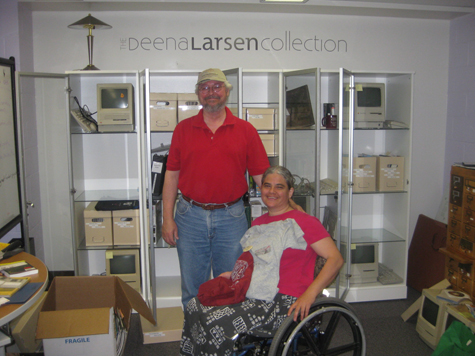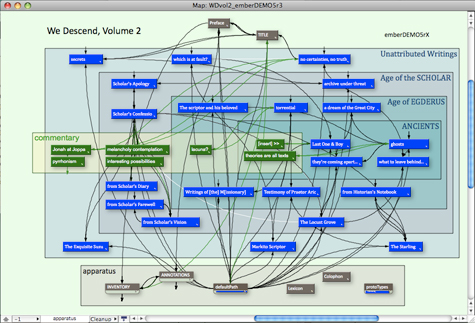In 2007, MITH acquired the Deena Larsen Collection (DLC). The collection consists of Macintosh SE computers, archived press materials, and early hypertexts and electronic literature from 1987 to 2004. I recently had the fortunate opportunity to sit down with Deena and fellow hypertext author, Bill Bly.
How did you both become involved in hypertext literature? Bill Bly: I had gotten a Mac in 1988, and loved it. Five years later, I learned about Storyspace, a Mac program distributed by Eastgate Systems, that let you write hypertext -- a novel that could be read more than one way. Mark Bernstein, Chief Scientist of Eastgate, sent me a copy of the program, and after a lot of experimentation and help from other writers of hypertext, I finished my own hypertext novel, We Descend -- oddly enough, a story about an archive.
Deena Larsen: I started out with a vision of a work that told the story mostly in the links: Marble Springs. Then I got interested in the form and function of hypertext literature. There were scattered folks, and we attached ourselves to the hypertext community because we didn't have one of our own. The Association of Computing Machinery (ACM) hypertext group was primarily science-based; we created a community of hypertext writers through these conferences.
What are the advantages of the hypertext form?
BB: The web is hypertext, but very, very simple in terms of what it can do with links. For example, on the web you can only send out one link from each anchor. In Storyspace, the older [hypertext] program, you can have multiple links from the same anchor, making for a much richer structure.
DL: First there was text. Now all of a sudden you can make text dance; there are links, sounds, images, much more than the spoken word. We get to explore. We get to explain. It's like going from walking to an airplane. You see all of the paths, all of the roads, which nodes are more important, the complete landscape.
How do you create a cohesive narrative plot in the hypertext if a reader may take multiple paths through the text at any given time?
BB: Think about how you read a novel: this happened, then that happened etc. We're used to reading novels in that way; authors are used to writing novels in a certain way; the author chooses the order in which you read them. Everybody encodes the story in their own way. Sequence is way over-emphasized when we're talking about print. Hypertext allows you to flip back in the sequence. The [hypertext] author takes away unnecessary sequence; if you're wiling to float a little bit, and engage with the interface, then it's not that different.
DL: Disappearing Rain is my mystery novel -- in many different forms you see the story evolve. Everybody reads in a different way. You create, within the same work, a lot of different complexities. We design for a variety of audiences. You can have a exploratory view of the work; something that seems very simple, can actually be very complex, which is the beauty of it.
How may MITH best preserve this collection, and make it accessible to researchers?
BB: So many electronic records have disappeared. We are at the edge of the cliff; stuff is falling over every day. We must save what we have.
DL: We want to document what happened in the incunabula of literature development. MITH can play a huge role by having a test-bed archive. MITH has these materials and scholars can come in and what was happening during this time. The collection contains extensive articles and press on "how the world reacted to the Internet." Someone may use this material to research the development of the concept of links as semantic tools, how people morphed the tools to meet literary needs. The field of digital archiving is becoming very large very quickly. Will this period become the digital dark age or the digital light age?
In fact, the Deena Larsen Collection has been consulted lately by Leighton Christiansen, Masters Candidate in Library and Information Science at University of Illinois at Urbana-Champaign. Leighton is writing his Master's Thesis on Deena Larsen’s significant, unreleased hypertext work, Marble Springs, Second Edition. Leighton recently visited the DLC at MITH and thoughtfully blogged about his research. Please stay tuned to the blog to read a series of posts written by Leighton about his research using the Deena Larsen Collection.


